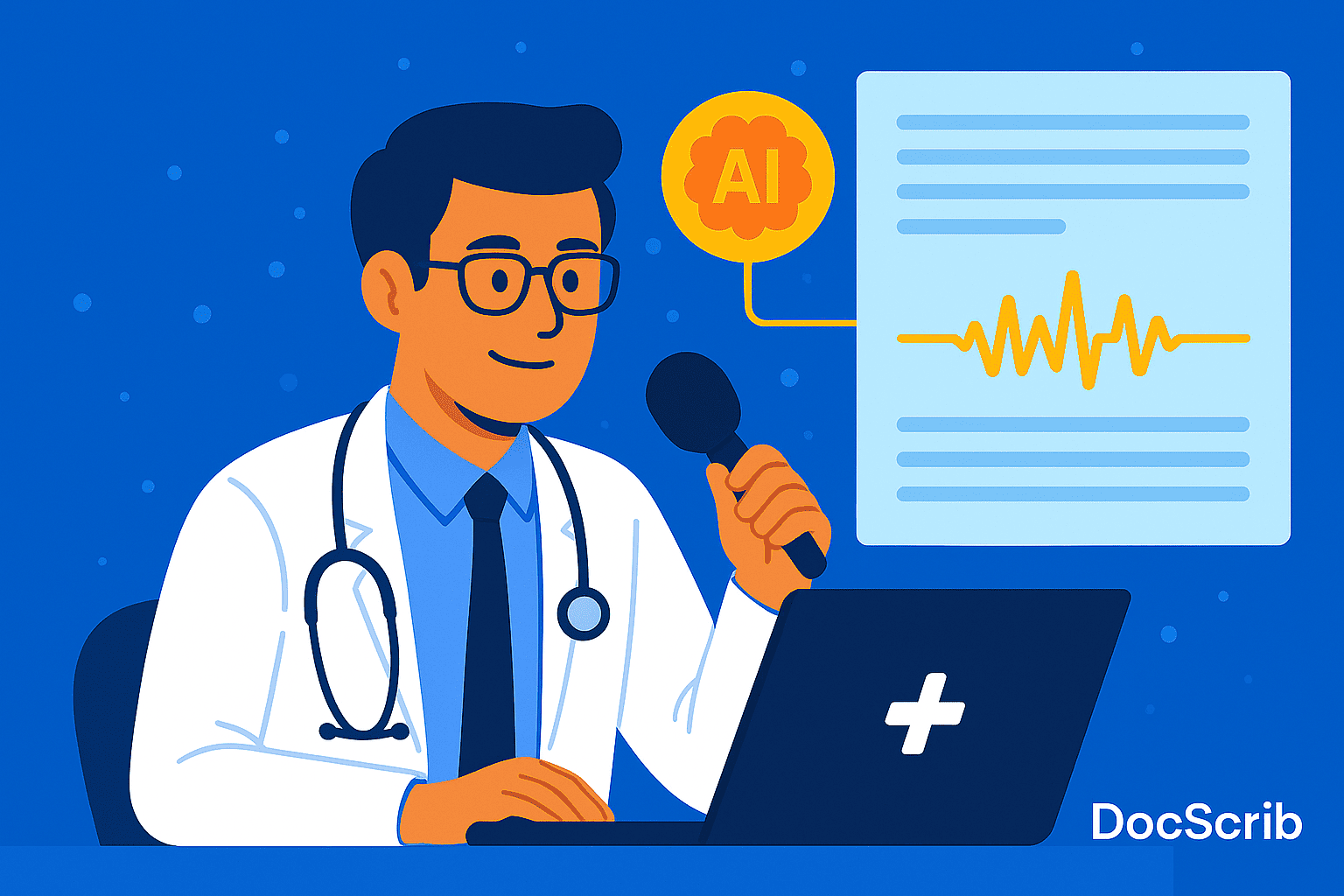Updated on: July 13, 2025
AI-driven medical dictation uses artificial intelligence—such as speech recognition and natural language processing (NLP)—to automatically capture and convert spoken clinician–patient interactions into structured electronic health record (EHR) notes. As direct transcription evolves from rudimentary dictation software to advanced ambient AI scribes, this technology reduces administrative burdens, boosts accuracy, improves patient interaction, and helps protect clinician wellbeing.
Evolution of Medical Dictation
- Early phase: Manual dictation tapes & typing services; slow, error-prone
- Intermediate: Speech-to-text tools needing manual correction
- Modern wave: Ambient AI scribes that passively listen, transcribe context, structure notes with little human intervention
In 2024, investments in ambient AI tools surged—from roughly $400 million to $800 million—fueling broader adoption as institutional use cases grew. Notable systems include Microsoft Dragon Copilot, Nabla, Suki, and Abridge. These tools now generate millions of clinic notes monthly and are credited with up to 50% reductions in documentation time.
How Modern AI Dictation Works
Core Components:
- Automatic Speech Recognition (ASR): Converts audio to raw text
- Natural Language Understanding (NLU): Filters clinical concepts, symptoms, labs, and orders
- Language Models / Summarizers: Restructure raw transcripts into consult notes (e.g., HPI, ROS, Assessment & Plan)
Example Workflow:
- AI records consult via smartphone or EHR integration
- ASR creates a transcript
- NLP identifies diagnoses, meds, and plans
- LLM structures this into a coherent note
- Clinician reviews and signs off
Platforms like Microsoft’s Dragon Copilot, Abridge, and Suki utilize proprietary ML models and HIPAA-compliant systems to automate this end-to-end process.
Benefits of AI Medical Dictation (with chart)
| Benefit | Impact |
|---|---|
| Significantly reduced documentation time | Up to 50% faster, saving clinicians 2–3 hours daily |
| Enhanced note quality & consistency | LLMs maintain structured formats across visits and specialties |
| Improved patient interaction | Clinicians stay present without typing; 90% report better eye contact |
| Reduced burnout & better work-life balance | Up to 4 hours less charting per night; higher job satisfaction |
| Rapid scalability & cost efficiency | Cloud-based AI scales to multiple providers at lower marginal cost |
Chart: A bar graph showing percentage reductions in documentation time across systems like Dragon Copilot, Abridge, and Nabla.
Challenges & Risks
- Speech recognition limitations
ASR may misinterpret accents, medical terminology, or ambient noise - AI “hallucinations”
LLMs sometimes generate plausible but false statements—potentially harmful in clinical documentation - Privacy & compliance
Patient consent, encryption, access controls, and data residency are critical for HIPAA compliance - Integration challenges
Integrating AI dictation into existing EHRs and workflows can be complex - Legal & ethical considerations
Consent, data ownership, and transparency need clear policies from tech vendors and healthcare providers
Best Practices for Implementation
- Obtain patient consent: Use written consent when AI tools record visits; inform patients about use and data handling.
- Start with pilot programs: Implement in low-risk settings to refine templates, workflows, and AI tuning.
- Hybrid editing workflows: Structure AI to draft notes, then require clinician review to correct errors before signing.
- Monitor quality metrics: Use scoring rubrics like PDQI-9 to evaluate accuracy, completeness, and relevance
- Continuous training: Improve ASR and LLM accuracy over time with local data.
- Prioritize security: Choose solutions with end-to-end encryption, HIPAA-compliance, and data logs.
- Maintain clinician oversight: AI supports decisions; clinicians retain ultimate clinical responsibility.
Future Trends
- Context-aware models: Combining imaging and EHR data to provide richer, multimodal documentation.
- Real-time clinical decision support: AI could suggest diagnostics or order sets during consultations.
- Federated learning: Enhances model accuracy without compromising data privacy.
- Regulatory shifts: Upcoming FDA/EMA guidelines will clarify generative AI documentation use.
- Language and locale expansion: Support for non-English languages and accents will grow, especially in diverse health systems.
Detailed FAQ
1. How accurate is AI dictation?
Current ASR accuracy ranges from ~90–95% in controlled settings, but LLM processing can add 5–10% error due to hallucinations or misinterpretations. Thus, clinician review always remains vital.
2. Are AI‑generated notes legally admissible?
Yes—with clinician approval. The provider must verify content before finalizing, maintaining accountability.
3. Is patient consent required?
Yes—especially for ambient recording. Explain how data is stored, used, and regulated under HIPAA.
4. What’s the cost investment?
Subscription models range from $99 to several hundred dollars monthly per provider. ROI typically arrives in 3–6 months via time recovery and increased patient volume.
5. What happens if the AI creates a false statement?
Clinicians must edit or remove inaccuracies. AI is an assistant—not a wholly autonomous decision-maker.
6. Can AI dictation handle complex specialty visits?
Yes—specialty-specific models (e.g., endocrinology, cardiology) outperform general models—but require customization and oversight.
7. Do AI dictation tools integrate with EHRs?
Top solutions (Dragon Copilot, Suki, Abridge) offer deep EHR integration for seamless note transfers.
8. Is transcription done locally or cloud-based?
Most solutions rely on HIPAA-secure cloud infrastructure. Some offer hybrid or local processing to reduce latency and safeguard PHI.
Conclusion
AI medical dictation represents a transformative leap in clinical documentation. By converting spoken interactions into properly structured notes, modern systems significantly reduce clinician workload, improve accuracy, and deepen patient engagement. A substantial provider time savings—up to 50%—translates into better work-life balance, fewer errors, and more efficient care delivery.
However, risks like speech recognition limitations, AI hallucinations, privacy concerns, and integration challenges must be carefully managed. With established best practices—such as patient consent, pilot testing, hybrid workflows, quality metrics, and security protocols—healthcare organizations can harness the benefits while minimizing risks.
At DocScrib, we build on this AI dictation revolution: our platform supports ambient capture, structured templates, coding suggestions, and EHR exports—all within a secure, compliant environment. Providers retain ultimate control, while AI handles heavy-lifting behind the scenes.
The future of medical documentation is here—intelligent, efficient, and patient-centered. To learn how AI medical dictation can elevate your organization, book a free demo with DocScrib today.
Experience the future of clinical documentation — Book your free DocScrib demo now and see it in action!
